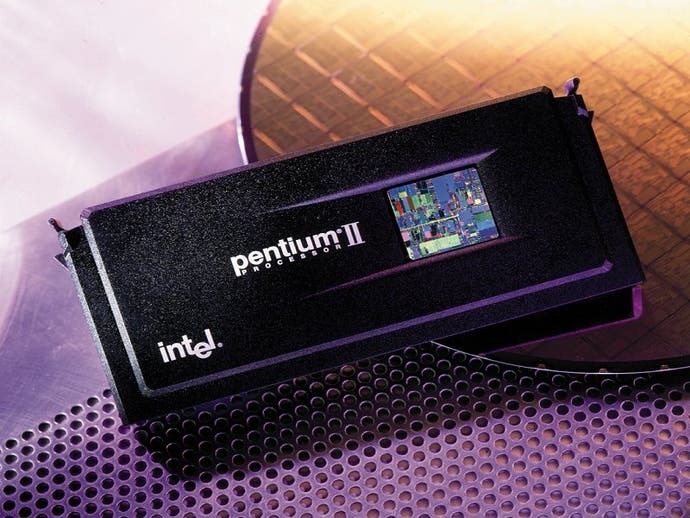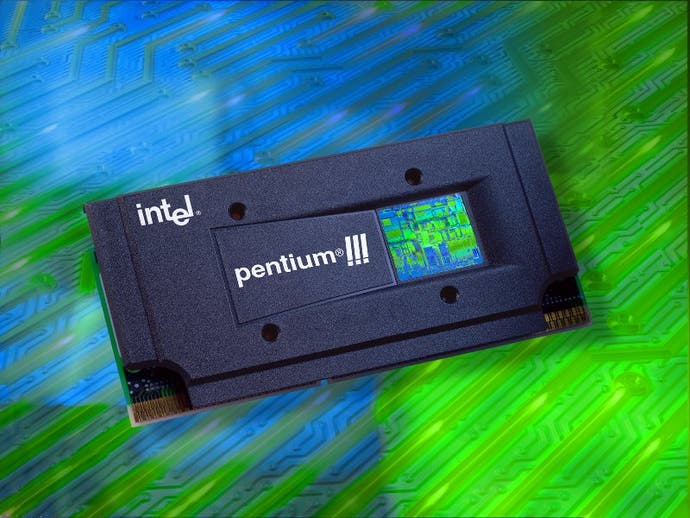Intel Pentium III 800MHz CPU
Intel CPU reviewed
- IntelPrice - about £550-£600

History Lesson
In the world of desktop computing there are many battles being fought, but there is only one real war. The eternal struggle of the chip makers like Intel, AMD and the late Cyrix (which is now part of VIA) has led to huge leaps in performance and speed in order to claim the accolade of "fastest x86 CPU".
Until recently Intel were undoubtedly the chipmaker of choice for gamers, as their all important FPU ("Floating Point Unit") was more powerful than anything the competition could throw out their doors. The Pentium MMX was a powerhouse at the time, and would put a K6 or Cyrix 6x86 to shame when it came to games. Its successor, the Pentium II, widened the performance gap even more.
Ultimately this high performance was to start the downfall for Intel. With such performance Intel chip pricing was equally high, making their processors a fairly unrealistic proposition for anyone building a system to a budget.
As a result the cheaper AMD processors become more popular, causing Intel to respond with the "budget" Celeron.

A Question Of Complexity
Early models of the Celeron did not include any level 2 processor cache (L2 cache), and as such their application performance was extremely poor. Games wise they were very good though, as the all important Pentium II core with its powerful FPU formed the basic design.
Shortly after it was announced that new Celerons would feature 128Kb of L2 cache, which sounded reasonable for a cheap chip. The special feature was that this cache would be running at the full speed of the CPU (as opposed to the half speed PII cache), and it would be on the same silicon as the CPU core. This yielded the Celeron 300A, one of the most complex chips ever attempted by Intel.
With 19 million transistors in the core it represented a massive leap from the 7.5 million of the Pentium II. It also had the unique feature of being extremely overclockable. As a result the Celeron was capable of performing as well as the more expensive Pentium II in both games and applications, and the on die cache was making all the difference.
More recently Intel released the Pentium III, and with it came SSE (Streaming SIMD Extensions). Unfortunately a Pentium III behaves in exactly the same way as the Pentium II, except that due to changes in the actual CPU die the chip can achieve higher clock speeds. As a result we have seen the Pentium III reach 600MHz.

Copper Mine
It is now that Intel have made another radical change to the Pentium III architecture in order to better respond to the threat of AMD's Athlon.
Intel's latest incarnation is the "CopperMine" core which, like the Celeron 300A, introduces on die L2 cache to the existing Pentium III core. This time Intel have decided to add 256Kb 'advanced transfer' cache to the chip, which makes the cache more efficient, and so helps to boost performance even further.
The chip itself is built on Intel's brand new 0.18 micron production lines, which allows for higher frequencies, lower operating voltages, and less thermal problems. This 0.18 process is also what makes it feasible to put 256Kb of cache on the chip die.
Another new design feature is the orientation of the silicon. Instead of being at the 'bottom' of the chip, and therefore not being cooled directly by the heatsink and fan, Intel have effectively flipped the chip over so that the silicon is at the top most surface of the chip. This has been designated 'flip chip' technology and allows for better cooling of the chip, which is a major factor when running as high as 800MHz.
Performance
The extra clock speed of the Pentium III 800 gives it a proportionate performance increase, and the faster cache is certainly helping to increase this lead slightly, though isn't any non-CopperMine Pentium III 800 it is impossible to know exactly what kind of performance boost is offered by the slightly smaller but faster L2 cache.
Conclusion
The Pentium III 800 is a super chip. Intel have reached a destination that 18 months ago nobody could really have foreseen them achieving so quickly. Of course it was inevitable that we would see CPU's reaching 800MHz and beyond, but with Intel finally getting some competition in the form of the Athlon we must wonder whether if left to its own devices Intel would have come this far so soon...
In terms of the two chips, the Athlon core is technically superior to that of the Pentium III (excluding the on die L2 cache), and it does still offer better performance on a clock for clock basis in most cases. But Intel have worked hard on creating a much more stable platform of core logic for their CPUs - I need only mention the age old but rock solid BX chipset, which has helped keep Intel at the top.
The Pentium III 800 is a good chip, and it would be very easy to build a very competent computer around it. It doesn't quite offer the fastest performance on the block in every case, especially given the recent announcement of 1GHz processors from both AMD and Intel, but most of the time you wouldn't be disappointed, and with the dependable BX chipset behind it you will have a machine as stable as money can buy.
